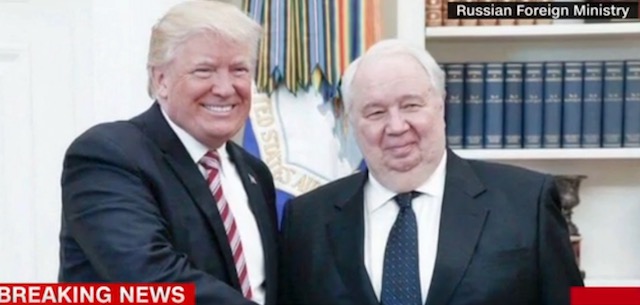But the same forces that brought about the danger can just as easily set it to rest.
We are now living in the most dangerous year since at least 1941, when the Third Reich was at the height of its power and fascism threatened to engulf the world. There are arguably more famines raging in the world today than at any time in generations, more failed states than at any time since the dissolution of the British and French empires, more groups committing genocide than at any time since the Second World War. But these troubles are merely symptomatic of deeper disorders and dwarfed by more global threats.
The two countries most capable of annihilating the planet through nuclear war are arguably led by more aggressive and callous leaders than at any time since the death of Stalin. Rightwing nationalists and fascists now head the greater portion of the world’s major states. The number of democratic states is in decline, with significant deterioration of democratic institutions in even the most well-established democracies. And the world order itself is fast becoming anarchic, dysfunctional, and prone to conflict.
Whereas famine is absent from the world in most years, with the last declared in Somalia in 2011, there are now 20 million people at risk of starvation in South Sudan, Northeastern Nigeria, Yemen, and Somalia. The famines now raging in these places have been described by a senior U.N. official as “the worst humanitarian crisis since 1945.” And whereas in most years, the world might band together to mitigate their worst damage, these have gone virtually unnoticed and have been largely ignored.
Most of these countries tend to top the listings of failed states, and the number of failed states has been growing for the past decade or so, with new states being added each year. Failed states tend to bleed refugees, terrorists, trafficked humans, and illegal drugs. They are often wracked with conflict. And the conflicts in Nigeria, South Sudan, and Somalia have made it difficult to farm and provide food aid. But the famine in Yemen has been largely manufactured through the deliberate bombing and blockading of ports and the obliteration of vital infrastructure.
Whereas scarcely a year goes by without some place in the world experiencing a level of mass murder approaching genocide, seldom are more than a couple of states engaging in such killings. And it is rare for large coalitions to engage in such killing together. But multiple states are arguably committing genocide against the rebel opposition in Syria now; and at least a dozen states, including the U.S. and U.K., are backing the Saudis forced starvation of Yemen. Meanwhile, ISIS is carrying out a genocide of Yezidis, and Burma against its minority Rohingya.
The challenges are interlinked. As the world order breaks down, nations retreat in the face of a more frightening world, and as nations retreat, the world becomes more frightening. State failure and genocide spur refugee flows, which lead developed nations to retreat in fear, and as developed nations retreat in fear, state failure and genocide carry on unchecked.
Whereas the world order has been largely stable since the Second World War, overseen by an array of multilateral organizations which in turn are overseen by a couple dozen or so developed democracies, the rise of rightwing nationalist and fascist governments in most major states threatens to smash that order to bits. Rightwing nationalists now head the U.S. and U.K., China and India, Russia and Turkey, Egypt and Saudi Arabia, Poland and Hungary. Together they threaten to make global concerted action a thing of the past. And all of this is complicated by democratic decline.
Whereas the number of democratic states has been rising now for hundreds of years, with brief declines in stair-step fashion, it has been declining for roughly a decade, and this may be the worst year yet. It is not simply that dictators have gotten better at maintaining power, citizens in states as varied as the Philippines and Egypt, America and Russia, are clambering for strong men under whose authority they might submit. And this has brought to power more dangerous leaders.
Whereas the two most heavily armed nuclear states have long been careful to avoid a nuclear showdown, with even most Soviet leaders since Stalin working for peace, the U.S. has just elected a potentially sociopathic and erratic leader in favor of their use, while Russia’s leader may be the most belligerent in the world today. With the global order in flux, and both leaders bolstered by a tough image, the potential for nuclear holocaust may have never been greater.
We cannot afford to panic right now, because panicking fuels the contraction into rightwing nationalism, which pits everyone against each other. But we need to recognize the crisis we are in, and that will mean a whole lot of panicking. It is a challenge common to every organization and human system in decline—panic but don’t panic—but this time it is the world system that is in rapid dissolution. This may actually be the most dangerous year ever in the history of human civilization..
Whereas the Third Reich threatened to sweep the world in 1941, today we can destroy the planet in an instant. Meanwhile, the global climate system is beginning to spiral out of control, and the global turn toward nationalism means climate change will get even less attention. Meanwhile nationalist governments will likely adopt pro-natalist programs, as they so often do, and this will intensify population stresses over time.
However, the greatest danger is not so much a nuclear Trump administration or even a rapid escalation of multiple global wars, but rather the vicious circle of unmet global challenges fueling a retreat into nationalism, which is all the worse for the failure of nationalist governments to take on the challenge of managing a deteriorating global order. If this is the case, then 2017 might mark the beginning of the end of human civilization.
But we simply do not know how long the fascist moment will last. We do not know if it has already reached its high water mark or if the worst is yet to come. And we do not know whether or not the same forces that brought it into being will undo it just as fast. Rightwing nationalists have been brought to power by the forces of globalization, mass inequality, technological complexity, a generational backlash, and social media. But each of these forces might just as well have brought about its opposite.
Over the course of the 21st century, we should expect ever cheaper and faster transportation, easier money transfers, increasing immigration, more technological interconnectivity, stronger global networks, and more interconnected global environmental challenges, whoever is in charge. Hence, those who would wish globalization away will ultimately fail.
Similarly, mass inequality is only likely to grow with increasing robotization and globalization. And it will be felt ever more strongly as we see more of people on the other side of the planet. But the rightwing nationalists have no solutions to inequality either; nor are they likely to turn back the clock on technological development.
The same forces that brought rightwing nationalists to power can just as easily take them out. It is just as easy for liberals to organize on social media as it is for conservatives, and for awhile it looked like social media would bring about another wave of democratization. Meanwhile, the generational backlash among Baby Boomers will be weakened with each passing year, as Millennials come to assume power and an older generation tires of pushing the river.
Nothing short of the fate of the world hangs in the balance between these two great global forces. Hence, 2017 may not only be the most dangerous year in the history of the world, but the most pivotal as well. And the outcome of this epic struggle is largely in our own hands.
~
If you liked this article, please check out my book, Convergence: The Globalization of Mind, and join the dialogue on Facebook.
~
~
~
Author: Theo Horesh
Image: CNN, video still
Editor: Travis May












Read 0 comments and reply